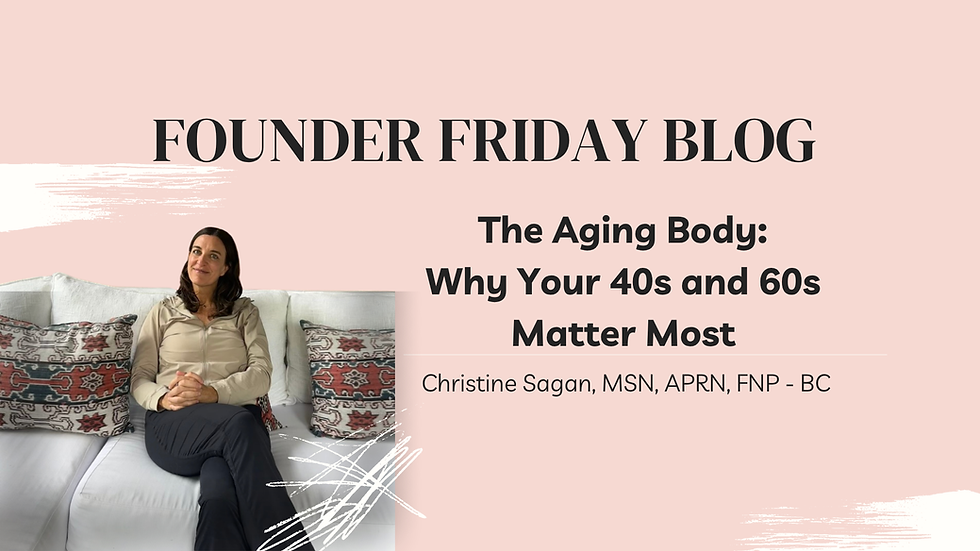Muscle Matters: How to Preserve Strength, Mobility, and Vitality Through Every Decade
- The Vitae Team

- Oct 1
- 2 min read
By Staci L. Johnson, MSN, APRN, FNP-BC

As we move through different decades of life, our bodies change in subtle but important ways. One area that deserves extra attention is muscle health. Beginning in our 30s and 40s, we naturally start to lose muscle mass—a process called sarcopenia. By the time we’re in our 50s and 60s, this can accelerate if not supported through lifestyle, nutrition, and, when appropriate, advanced therapies. The loss of one's core strength, which includes the abdominal muscles and gluteal muscles, requires other smaller muscles to be recruited to assist with mobility. This core strength loss increases your overall risk of experiencing muscle, tendon, and ligament injuries by more than 50% as you age.
Why Muscle Matters
Muscle health isn’t only about strength and appearance—it’s about function, mobility, and independence. Healthy muscle helps maintain metabolism, supports bone health, reduces fall risk, and improves overall quality of life.
Hormonal Shifts & Muscle Loss
Women in midlife will notice muscle changes tied to estrogen decline during perimenopause and menopause. Estrogen plays a role in muscle repair and metabolism.
Men in midlife will experience lower testosterone, which impacts muscle mass, recovery, and energy.
Both sexes experience a decrease in growth hormone, IGF-1, and mitochondrial efficiency, which can affect endurance and resilience.
What can one do to reduce muscle loss at any age:
Nutrition: Adequate protein, omega-3 fatty acids, creatine, and macronutrients/micronutrients are essential. You CANNOT supplement a poor-quality diet.
Amino Acid & Muscle-Specific Support
Essential Amino Acids (EAAs): 10–15 g per day, divided doses (often during workout or between meals).
BCAAs (leucine, isoleucine, valine): 5–10 g before/after resistance training if not using full EAAs.
Creatine Monohydrate: 3–5 g daily (safe long-term; no need for cycling).
Mitochondrial Support
Vitamin D3: 2,000–5,000 IU daily (adjust to maintain serum 50–80 ng/mL).
Magnesium (glycinate, malate, or citrate): 200–400 mg daily, ideally in the evening.
CoQ10 (Ubiquinol form preferred): 100–300 mg daily, especially if on statins or fatigued.
NAD+ (injectable is the best form): the goal is 100mg weekly or NMR/NR/Niacin are daily oral NAD+ precursors that are thought to increase NAD+
Metabolic & Recovery Support
Omega-3 Fatty Acids (EPA/DHA): 2,000–3,000 mg combined EPA+DHA daily (higher end for inflammation/metabolic syndrome).
Collagen Peptides: 10–20 g daily (best with 500–1,000 mg vitamin C to enhance collagen cross-linking).
Alpha-Lipoic Acid (ALA): 200–600 mg daily, with a meal.
Additional Nutrients
Good quality multivitamin: daily
(If not taking a multivitamin-) Zinc (picolinate or citrate):15–30 mg daily (especially for testosterone and repair).
(If not taking a multivitamin)- Selenium: 100–200 mcg daily (supports thyroid and antioxidant defense).
Adaptogens (Ashwagandha, Rhodiola): Ashwagandha 300–600 mg/day (standardized extract), Rhodiola 200–400 mg/day — both support cortisol balance and recovery.
Strength Training: Weight-bearing and resistance exercises are essential at every age.
Lifestyle: ***MOST IMPORTANT*** Prioritize quality sleep, effective stress management, and an active lifestyle.
Advanced Support: In addition to lifestyle, some patients benefit from targeted hormonal optimization or innovative muscle-building therapies like Emsculpt—a noninvasive option that uses electromagnetic stimulation to contract muscles deeply and effectively.
The good news? Muscle health is resilient. With the right support, it’s possible to not only preserve but also enhance strength and vitality at every stage of life.


Comments